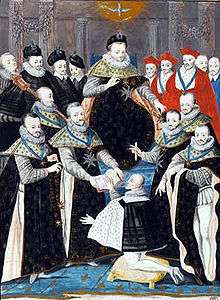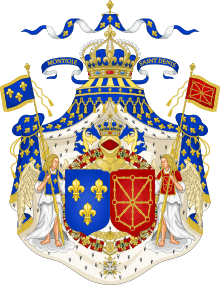Order of the Holy Spirit
- Not to be confused with the Congregation of the Holy Ghost (Spiritans).
| Order of the Holy Spirit Ordre du Saint-Esprit | |
|---|---|
.svg.png) | |
| Badge of the Order | |
| Award of the Kingdom of France | |
| Type | Chivalric order |
| Royal house | House of France |
| Religious affiliation | Roman Catholic |
| Ribbon | Light blue |
| Motto | Duce et Auspice |
| Status | Abolished in 1830 |
| Founder | Henry III of France |
| Established | December 31, 1578 |
| Precedence | |
| Next (lower) | Order of Saint Michael |
| | |
| Ribbon of the Order | |
The Order of the Holy Spirit, also known as the Order of the Knights of the Holy Spirit, (French: Ordre du Saint-Esprit or Ordre des chevaliers du Saint-Esprit; sometimes translated into English as the Order of the Holy Ghost)[1] was an order of chivalry under the French monarchy.[2] It should not be confused with the Congregation of the Holy Ghost or with the religious Order of the Holy Ghost.[1] It was the senior chivalric order of France by precedence, although not by age, since the Order of Saint Michael was established more than a century earlier.
History
Prior to the creation of the Order of the Holy Spirit in 1578 by Henri III, the senior order of chivalry in France had been the Order of Saint Michael.[2] This order had originally been created to rival the Burgundian Order of the Golden Fleece, and to help ensure that leading French nobles remained loyal to the Crown. Its membership was initially restricted to a small number of powerful princes and nobles, but this increased dramatically due to the pressures of the Wars of Religion: at the beginning of the reign of Henry III, the order had several hundred living members, ranging from kings to bourgeois. Recognising that the order had been significantly devalued, Henry founded the Order of the Holy Spirit December 31, 1578- thereby creating a two-tier system: the new order would be reserved for princes and powerful nobles whilst the old Order of Saint Michael would be given to less eminent servants of the Crown. This Order was dedicated to the Holy Spirit to commemorate the fact that Henry was elected King of Poland (1573) and inherited the throne of France (1574) on two Pentecosts.
During the French Revolution the Order of the Holy Spirit was officially abolished by the French government along with all other chivalric orders from the Ancien Régime, although the exiled Louis XVIII continued to acknowledge it. Following the Restoration, the order was officially revived, only to be abolished again by the Orleanist Louis-Philippe following the July Revolution in 1830. Despite the abolition of the order, both the Orleanist[2] and Legitimist[3] pretenders to the French throne have continued to nominate members of the order, long after the abolition of the French monarchy itself.
Composition

The King of France was the Sovereign and Grand Master ("Souverain Grand Maître"), and made all appointments to the order. Members of the order can be split into three categories:
- 8 Ecclesiastic members
- 4 Officers
- 100 Knights
Initially, four of the ecclesiastic members had to be cardinals, whilst the other four had to be archbishops or prelates. This was later relaxed so that all eight had to be either cardinals, archbishops or prelates.
Members of the order had to be Roman Catholic, and had to be able to demonstrate three degrees of nobility. The minimum age for members was 35, although there were some exceptions:
- Children of the king were members from birth, but weren't received into the order until they were 12.
- Princes of the Blood could be admitted to the order from the age of 16
- Foreign royalty could be admitted to the order from the age of 25
All Knights of the order were also members of the Order of Saint Michael. As such, they were generally known as "Chevalier des Ordres du Roi" (i.e. "Knights of the Royal Orders"), instead of the more lengthy "Chevalier de Saint-Michel et Chevalier du Saint-Esprit" (i.e. "Knight of Saint Michael and Knight of the Holy Spirit").
Officers
%2C.jpg)
The order had its own officers. They were responsible for the ceremonies and the administration of the order.
officers of the order were as follows:
- Chancellor
- Provost and Master of Ceremonies
- Treasurer
- Clerk (greffier)
Vestments and accoutrements
The symbol of the order is known as the Cross of the Holy Spirit. (This is a Maltese Cross); at the periphery, the eight points of the cross are rounded, and between each pair of arms there is a fleur-de-lis. Imposed on the centre of the cross is a dove. The eight rounded corners represent the Beatitudes, the four fleur-de-lis represent the Gospels, the twelve petals represent the Apostles, and the dove signifies the Holy Spirit. The Cross of the Holy Spirit was worn hung from a blue riband ("Le cordon bleu").[4]
Cordon Bleu
Due to the blue riband from which the Cross of the Holy Spirit was hung, the Knights became known as "Les Cordon Bleus". Over time, this expression was extended to refer to other distinctions of the highest class – for example, Cordon Bleu cooking and Blue Riband sporting events. It has been suggested that the term Cordon Bleu in cooking has derived from the splendour of feasts held by the Knights and not simply from the term becoming synonymous with prestige; however, this is not confirmed.
Habit and insignia
The badge of the Order is a gold Maltese cross with white borders, each of the eight points ending in a gold ball (points boutonnées) and with a gold fleur-de-lys between each adjacent pair of its arms. At the center of the cross, was set a white dove descending (i.e., with its wings and head pointing downward) surrounded by green flames. The back of this cross worn by the knights was the same as the front except with the medallion of the Order of Saint Michael at the center rather than the dove and flames (those of ecclesiastical members were the same on the back as on the front). During the ceremonies, the cross of officers and commanders officers was attached to a collar of links of gold fleur-de-lis alternating with links consisting of a white enameled letter H (the first initial of name of the founder) crowned with a gold French royal crown, with identical crowns on either side of it or alternately with a trophy of weapons. Each of these links was surrounded with red enamel flames forming a square around it. More generally, the cross was suspended from a large ribbon of color moirée blue sky, hence the nickname cordon bleu the knights wore.
For the ceremonies of the Order and when the knights of the Order made their Communion the knights wore a long black velvet mantle sprinkled with embroidered gold and red flames and with a representation of the collar round its edges embroidered in gold, red and silver. Like the royal mantle, this mantle opened on the right side and just as an ermine shoulder cape covered the top of the royal mantle, a shoulder cape of pale green velvet with the same embroidery but smaller was worn over this mantle and formed the upper part of it. Both the mantle proper and the shoulder cape were lined with a yellowish orange satin. The mantle was worn over a white coat (with the star of the Order embroidered on the left breast), waistcoat and puffed hose, heavily embroided with silver. A black hat with a white plume completed the dress. The star of the Order had the same design as the front of the badge, but embroidered in silver (later a medal star in silver was used) on both the knights' coats and their vests.
.svg.png) Badge of the Order
Badge of the Order.svg.png) Collar of the Order
Collar of the Order Collar of the Order shown in the arms of France and Navarre
Collar of the Order shown in the arms of France and Navarre
Special privileges
In France, red or green sealing wax was used for the royal seal on documents requiring a royal seal. Only in documents relating to the Order of the Holy Spirit was white wax used for this royal seal.
See also
| Wikimedia Commons has media related to Order of the Holy Spirit. |
References
- 1 2 Moeller, Charles (1910). "Orders of the Holy Ghost". The Catholic Encyclopedia. New York: Robert Appleton Company. 7. Retrieved 21 December 2012.
A distinction must be drawn between this order and the Royal Order of the Holy Spirit founded in France by King Henry III, in 1578, to supersede the Order of St. Michael of Louis XI, which had fallen into discredit, and to commemorate his accession to the throne on Pentecost Sunday. This was a purely secular order of the court.
- 1 2 3 Cardinale, Hyginus Eugene: edited and revised by Peter Bander van Duren; Duren, revised by Peter Bander van (1984). Orders of knighhood, awards and the Holy See ([Rev. ed.]. ed.). Gerrards Cross, Buckinghamshire: Van Duren. pp. 154–56. ISBN 0905715233.
The Royal House of Bourbon-Orléans, The Order of the Holy Ghost: The Order was founded in 1578 by Henry III, King of France (1574-1589) to mark his election to the Crown of Poland and elevation to the throne of France....The Order of St. Michael of France.
Cite uses deprecated parameter|coauthors=(help) - ↑ État présent de la maison de Bourbon. Quatrième édition. Paris, Le Léopard d'or, 1991; p. 222: « Louis XIX, Henri V, Charles XI et Jaques I continuèrent à donner l'ordre dans la discrétion et en 1972, Jacques-Henri VI suivit leur exemple, sont fils Alphonse II faisant de même. » L’État présent… donne ensuite le nom de quatre chevaliers, créés par lettres patentes de 1972 et 1973.
- ↑ Now You Know Royalty – Page 108 Doug Lennox – 2009 "Why is a first-class chef called a "cordon bleu"? This term comes from our French kings. The cordon bleu was the blue ribbon worn by Knights of the Order of the Holy Spirit, the French equivalent of the Order of the Garter, founded in 1578 by ..."